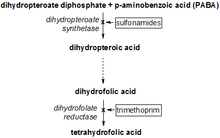| Revision as of 12:14, 20 December 2017 edit103.240.170.34 (talk) →External links← Previous edit | Revision as of 12:47, 20 December 2017 edit undoEdgar181 (talk | contribs)Extended confirmed users196,325 edits Undid revision 816288480 by 103.240.170.34 (talk)Next edit → | ||
| Line 132: | Line 132: | ||
| ==External links== | ==External links== | ||
| * {{dead link|date=December 2017 |bot=InternetArchiveBot |fix-attempted=yes }} (PDF file). | |||
| * . | |||
| {{Sulfonamides and trimethoprim}} | {{Sulfonamides and trimethoprim}} | ||
Revision as of 12:47, 20 December 2017
Not to be confused with Thymidine monophosphate. Pharmaceutical compound | |
 | |
| Clinical data | |
|---|---|
| Pronunciation | /traɪˈmɛθəprɪm/ |
| Trade names | Proloprim, Monotrim, Triprim, others |
| AHFS/Drugs.com | Monograph |
| MedlinePlus | a684025 |
| License data |
|
| Pregnancy category |
|
| Routes of administration | Oral |
| ATC code | |
| Legal status | |
| Legal status | |
| Pharmacokinetic data | |
| Bioavailability | 90–100% |
| Protein binding | 44% |
| Metabolism | hepatic |
| Elimination half-life | 8-12 hours |
| Excretion | Urine (50–60%), faeces (4%) |
| Identifiers | |
IUPAC name
| |
| CAS Number | |
| PubChem CID | |
| DrugBank | |
| ChemSpider | |
| UNII | |
| KEGG | |
| ChEBI | |
| ChEMBL | |
| PDB ligand | |
| CompTox Dashboard (EPA) | |
| ECHA InfoCard | 100.010.915 |
| Chemical and physical data | |
| Formula | C14H18N4O3 |
| Molar mass | 290.32 g/mol g·mol |
| 3D model (JSmol) | |
SMILES
| |
InChI
| |
| (verify) | |
Trimethoprim (TMP) is an antibiotic used mainly in the treatment of bladder infections. Other uses include for middle ear infections and travelers' diarrhea. With sulfamethoxazole or dapsone it may be used for Pneumocystis pneumonia in people with HIV/AIDS. It is taken by mouth.
Common side effects include nausea, changes in taste, and rash. Rarely it may result in blood problems such as not enough platelets or white blood cells. May cause sun sensitivity. There is evidence of potential harm during pregnancy in some animals but not humans. It works by blocking folate metabolism via dihydrofolate reductase in some bacteria which results in their death.
Trimethoprim was first used in 1962. It is on the World Health Organization's List of Essential Medicines, the most effective and safe medicines needed in a health system. It is available as a generic medication and is not very expensive. In the United States 10 days of treatment is about 21 USD.
Medical uses
It is primarily used in the treatment of urinary tract infections, although it may be used against any susceptible aerobic bacterial species. It may also be used to treat and prevent Pneumocystis jiroveci pneumonia. It is generally not recommended for the treatment of anaerobic infections such as Clostridium difficile colitis (the leading cause of antibiotic-induced diarrhea). Trimethoprim has been used in trials to treat retinitis.
Resistance to trimethoprim is increasing, but it is still a first line antibiotic in many countries.
Spectrum of susceptibility
Cultures and susceptibility tests should be done to make sure bacteria is treated by trimethoprim.
- Escherichia coli
- Proteus mirabilis
- Klebsiella pneumoniae
- Enterobacter species
- Coagulase-negative Staphylococcus species, including S. saprophyticus
- Streptococcus pneumoniae
- Haemophilus influenzae
Side effects
Common
- Nausea
- Change in taste
- Vomiting
- Diarrhea
- Rash
- Sun sensitivity
- Itchiness
Rare
- Can cause thrombocytopenia (low levels of platelets) by lowering folic acid levels; this may also cause megaloblastic anemia.
- Trimethoprim antagonizes the epithelial sodium channel in the distal tubule, thus acting like amiloride. This can cause increased potassium levels in the body (hyperkalemia).
- Can compete with creatinine for secretion into the renal tubule. This can cause an artificial rise in the serum creatinine.
- Use in EHEC infections may lead to an increase in expression of Shiga toxin.
Contraindications
- Known hypersensitivity to trimethoprim
- History of megaloblastic anemia due to folate deficiency
Liver and kidney problems
10-20% of trimethoprim is metabolized by the liver and the rest is excreted in the urine. Therefore, trimethoprim should be used with caution in individuals with kidney and liver impairments. Dosage adjustment is not needed for liver impairment but should be adjusted for kidney impairment.
Pregnancy
Based on studies that show that trimethoprim crosses the placenta and can affect folate metabolism, there has been growing evidence of the risk of structural birth defects associated with trimethoprim, especially during the first trimester of pregnancy. It may be involved in a reaction similar to disulfiram when alcohol is consumed after it is used, in particular when used in combination with sulfamethoxazole. The trophoblasts in the early fetus are sensitive to changes in the folate cycle. A recent study has found a doubling in the risk of miscarriage in women exposed to trimethoprim in the early pregnancy.
Mechanism of action


Trimethoprim binds to dihydrofolate reductase and inhibits the reduction of dihydrofolic acid (DHF) to tetrahydrofolic acid (THF). THF is an essential precursor in the thymidine synthesis pathway and interference with this pathway inhibits bacterial DNA synthesis. Trimethoprim's affinity for bacterial dihydrofolate reductase is several thousand times greater than its affinity for human dihydrofolate reductase. Sulfamethoxazole inhibits dihydropteroate synthase, an enzyme involved further upstream in the same pathway. Trimethoprim and sulfamethoxazole are commonly used in combination due to possible synergistic effects, and reduced development of resistance. This benefit has been questioned.
History
Trimethoprim was first used in 1962. In 1972, it was used as a prophylactic treatment for urinary tract infections in Finland.
See also
References
- ^ "Trimethoprim". The American Society of Health-System Pharmacists. Archived from the original on 2015-09-24. Retrieved Aug 1, 2015.
{{cite web}}: Unknown parameter|deadurl=ignored (|url-status=suggested) (help) - Masur, H; Brooks, JT; Benson, CA; Holmes, KK; Pau, AK; Kaplan, JE; National Institutes of, Health; Centers for Disease Control and, Prevention; HIV Medicine Association of the Infectious Diseases Society of, America (May 2014). "Prevention and treatment of opportunistic infections in HIV-infected adults and adolescents: Updated Guidelines from the Centers for Disease Control and Prevention, National Institutes of Health, and HIV Medicine Association of the Infectious Diseases Society of America". Clinical Infectious Diseases. 58 (9): 1308–11. doi:10.1093/cid/ciu094. PMC 3982842. PMID 24585567.
- "Prescribing medicines in pregnancy database". Australian Government. 3 March 2014. Archived from the original on 8 April 2014. Retrieved 22 April 2014.
{{cite web}}: Unknown parameter|deadurl=ignored (|url-status=suggested) (help) - ^ Huovinen, P (1 June 2001). "Resistance to trimethoprim-sulfamethoxazole". Clinical Infectious Diseases. 32 (11): 1608–14. doi:10.1086/320532. PMID 11340533.
- "WHO Model List of Essential Medicines (19th List)" (PDF). World Health Organization. April 2015. Archived from the original (PDF) on 13 December 2016. Retrieved 8 December 2016.
{{cite web}}: Unknown parameter|deadurl=ignored (|url-status=suggested) (help) - Hamilton, Richart (2015). Tarascon Pocket Pharmacopoeia 2015 Deluxe Lab-Coat Edition. Jones & Bartlett Learning. p. 113. ISBN 9781284057560.
- ^ Rossi, S, ed. (2013). Australian Medicines Handbook (2013 ed.). Adelaide: The Australian Medicines Handbook Unit Trust. ISBN 978-0-9805790-9-3.
- Pradhan E, Bhandari S, Gilbert RE, Stanford M (2016). "Antibiotics versus no treatment for toxoplasma retinochoroiditis". Cochrane Database Syst Rev. 5: CD002218. doi:10.1002/14651858.CD002218.pub2. PMID 27198629.
{{cite journal}}: CS1 maint: multiple names: authors list (link) - "Archived copy". Archived from the original on 2015-12-08. Retrieved 2015-12-30.
{{cite web}}: Unknown parameter|deadurl=ignored (|url-status=suggested) (help)CS1 maint: archived copy as title (link) - "DailyMed - TRIMETHOPRIM- trimethoprim tablet". dailymed.nlm.nih.gov. Archived from the original on 2015-09-30. Retrieved 2015-11-04.
{{cite web}}: Unknown parameter|deadurl=ignored (|url-status=suggested) (help) - "DailyMed - PRIMSOL- trimethoprim hydrochloride solution". dailymed.nlm.nih.gov. Archived from the original on 2015-11-17. Retrieved 2015-11-04.
{{cite web}}: Unknown parameter|deadurl=ignored (|url-status=suggested) (help) - "PROLOPRIM® (trimethoprim)100-mg and 200-mg Scored Tablets". dailymed.nlm.nih.gov. Archived from the original on 2015-11-17. Retrieved 2015-11-04.
{{cite web}}: Unknown parameter|deadurl=ignored (|url-status=suggested) (help) - Ellenhorn, M.J.; S. Schonwald; G. Ordog; J. Wasserberger. American Hospital Formulary Service- Drug Information 2002. Baltimore, MD: Williams and Wilkins. p. 236.
- MICROMEDEX Thomson Health Care. USPDIpublisher = Thomson Health. Drug Information for the Health Care Professional. 22nd ed. Volume 1. CareGreenwood Village, CO. 2002 p. 2849.
{{cite book}}: CS1 maint: location (link) - Choi, Michael J.; Fernandez, Pedro C.; Patnaik, Asit; Coupaye-Gerard, Brigitte; D'Andrea, Denise; Szerlip, Harold; Kleyman, Thomas R. (1993-03-11). "Trimethoprim-Induced Hyperkalemia in a Patient with AIDS". New England Journal of Medicine. 328 (10): 703–706. doi:10.1056/NEJM199303113281006. ISSN 0028-4793. PMID 8433730.
- Naderer, O.; Nafziger, A. N.; Bertino, J. S. (1997-11-01). "Effects of moderate-dose versus high-dose trimethoprim on serum creatinine and creatinine clearance and adverse reactions". Antimicrobial Agents and Chemotherapy. 41 (11): 2466–2470. ISSN 0066-4804. PMC 164146. PMID 9371351.
- Kimmitt PT, Harwood CR, Barer MR (2000). "Toxin Gene Expression by Shiga Toxin-producing Escherichia coli: The Role of Antibiotics and the Bacterial SOS Response" (PDF). Emerg Infect Dis. 6 (5): 458–465. doi:10.3201/eid0605.000503. PMC 2627954. PMID 10998375. Archived from the original (pdf) on 2017-09-08.
{{cite journal}}: Unknown parameter|deadurl=ignored (|url-status=suggested) (help) - "DailyMed - PRIMSOL- trimethoprim hydrochloride solution". dailymed.nlm.nih.gov. Archived from the original on 2015-11-17. Retrieved 2015-11-04.
{{cite web}}: Unknown parameter|deadurl=ignored (|url-status=suggested) (help) - "DailyMed - TRIMETHOPRIM- trimethoprim tablet". dailymed.nlm.nih.gov. Archived from the original on 2015-09-30. Retrieved 2015-11-04.
{{cite web}}: Unknown parameter|deadurl=ignored (|url-status=suggested) (help) - Sivojelezova, Anna; Einarson, Adrienne; Shuhaiber, Samar; Koren, Gideon (2003-09-01). "Trimethoprim-sulfonamide combination therapy in early pregnancy". Canadian Family Physician. 49: 1085–1086. ISSN 0008-350X. PMC 2214286. PMID 14526858.
- Edwards DL, Fink PC, van Dyke PO (1986). "Disulfiram-like reaction associated with intravenous trimethoprim-sulfamethoxazole and metronidazole". J Clinical pharmacy. 5 (12): 999–1000. PMID 3492326. Archived from the original on 2009-01-24.
{{cite journal}}: Unknown parameter|deadurl=ignored (|url-status=suggested) (help) - Heelon MW, White M (1998). "Disulfiram cotrimoxazole reaction". J Pharmacotherapy. 18 (4): 869–870. PMID 9692665. Archived from the original on 2009-01-24.
{{cite journal}}: Unknown parameter|deadurl=ignored (|url-status=suggested) (help) - Andersen JT, Petersen M, Jimenez-Solem E, Broedbaek K, Andersen EW, Andersen NL, Afzal S, Torp-Pedersen C, Keiding N, Poulsen HE (2013). "Trimethoprim use in early pregnancy and the risk of miscarriage: a register-based nationwide cohort study". Epidemiology and Infection. 141 (8): 1749–1755. doi:10.1017/S0950268812002178. PMID 23010291. Archived from the original on 2013-09-29.
{{cite journal}}: Unknown parameter|deadurl=ignored (|url-status=suggested) (help) - Heaslet, H.; Harris, M.; Fahnoe, K.; Sarver, R.; Putz, H.; Chang, J.; Subramanyam, C.; Barreiro, G.; Miller, J. R. (2009). "Structural comparison of chromosomal and exogenous dihydrofolate reductase fromStaphylococcus aureusin complex with the potent inhibitor trimethoprim". Proteins: Structure, Function, and Bioinformatics. 76 (3): 706–717. doi:10.1002/prot.22383. PMID 19280600.
- ^ Brogden, RN; Carmine, AA; Heel, RC; Speight, TM; Avery, GS (June 1982). "Trimethoprim: a review of its antibacterial activity, pharmacokinetics and therapeutic use in urinary tract infections". Drugs. 23 (6): 405–30. doi:10.2165/00003495-198223060-00001. PMID 7049657.
- Brumfitt, W; Hamilton-Miller, JM (December 1993). "Reassessment of the rationale for the combinations of sulphonamides with diaminopyrimidines". Journal of Chemotherapy. 5 (6): 465–9. PMID 8195839.
External links
- Nucleic acid inhibitors (PDF file).
| Antibacterials that inhibit nucleic acid (J01E, J01M) | |||||||||||||||||
|---|---|---|---|---|---|---|---|---|---|---|---|---|---|---|---|---|---|
| Antifolates (inhibit bacterial purine metabolism, thereby inhibiting DNA and RNA synthesis) |
| ||||||||||||||||
| Quinolones (inhibit bacterial topoisomerase and/or DNA gyrase, thereby inhibiting DNA replication) |
| ||||||||||||||||
| Anaerobic DNA inhibitors |
| ||||||||||||||||
| RNA synthesis |
| ||||||||||||||||
| |||||||||||||||||